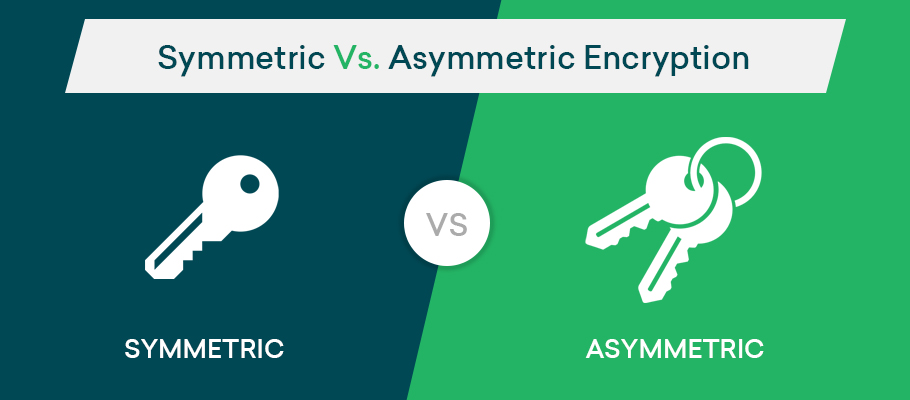Asymmetric Encryption is much secure than Symmetric Encryption. Asymmetric Encryption use Public Key & Private key while Symmetric encryption only use one Secret key to encrypt and decrypt the message. In terms of Speed, symmetric encryption is faster compared to Asymmetric encryption.

Let’s find the differences between symmetric vs asymmetric encryption in details like key length, algorithm types, performance and more.
We use unsecured media such as the Internet to communicate on a daily basis. While at it, how many of us pause to take into consideration the confidentiality of the information that we are sharing with each other? The most commonly applied method for securing information during the communication process is known as encryption, which is a major concept of cryptography.
Encryption can simply be defined as the process through which a sender of information encodes a message to a format that is difficult for an eavesdropper to decipher.
What is Encryption & Cryptographic Keys?
Encryption is actually an age-old practice dating back to the times of the famous Roman king Caesar, who encrypted his messages using a Caesar cipher. The practice can be viewed as a transformation of information whereby the sender uses plain text, which is then encoded into cipher text to ensure that no eavesdropper interferes with the original plain text. On receiving the encoded message, the intended receiver decrypts it to obtain the original plain text message.
Once the transaction data encrypted then it can only be decrypted using the appropriate keys, its called a “Cryptographic keys“. A cryptographic key is a password which is used to encrypt and decrypt information. There are two types of cryptographic keys. They are known as symmetric key and asymmetric key cryptography.
Types of Encryption
There are two main types of encryption:
- Symmetric Encryption
- Asymmetric Encryption
How Encryption Key Systems Work
Symmetric Key Systems
First, let’s establish a few definitions:
- Data encryption key (DEK): is an encryption key whose function it is to encrypt and decrypt the data.
- Key encryption key (KEK): is an encryption key whose function it is to encrypt and decrypt the DEK.
- Key management application program interface (KM API): is an application interface that is designed to securely retrieve and pass along encryption keys from a key management server to the client requesting the keys.
- Certificate Authority (CA): is an entity that creates public and private keys, creates certificates, verifies certificates and performs other PKI functions.
- Transport layer security (TLS): is a cryptographic protocol that provides security, through mutual authentication, for data-in-motion over a computer network.
- Key Management System (KMS): is the system that houses the key management software
What is Symmetric Encryption?
Symmetric Encryption also called Secret Key Cryptography, it employs the same secret key for both encryption and decryption, that is used to exchange information during a secure session between the client’s browser and web server with an SSL Certificate.

This is an interactive graphic, click on the numbers above to learn more about each step
Now that we have the definitions in place, below is a step by step example of how an authorized user accesses encrypted data:
- A user requests to access encrypted data.
- The database, application, file system, or storage then sends a DEK retrieval request to the client (KM API).
- Next, the client (KM API) and KM verify each other’s certificates:
- The client (KM API) sends a certificate to the KM for verification.
- The KM then checks the certificate against the CA for authentication.
- Once the client (KM API) certificate has been verified, the KM then sends its certificate to the KM API for authentication and acceptance.
- Once the certificates have been accepted, a secure TLS connection is established between the client (KM API) and the KM.
- The KM then decrypts the requested DEK with the KEK
- The KM sends the DEK to the client (KM API) over the encrypted TLS session.
- The KM API then sends the DEK to the database, application, file system, or storage.
- The database (may) cache the DEK in temporary secure memory.
- The database, application, file system, or storage then sends the plaintext information to the user.

- The Sender and Recipient verify each other’s certificates:
- The sender sends a certificate to the recipient for verification.
- The recipient then checks the certificate against their Certificate Authority (CA) or an external Validation Authority (VA) for authentication.
- Once the sender’s certificate has been verified, the recipient then sends their certificate to the sender for authentication and acceptance.
- Once the sender and recipient have mutual acceptance:
- The sender requests the recipient’s public key.
- The recipient sends their public key to the sender.
- The sender creates an ephemeral symmetric key and encrypts the file to be sent. (an ephemeral symmetric key is a symmetric encryption key used only for one session)
- The sender encrypts the symmetric key with the public key.
- The sender then sends the encrypted data with the encrypted symmetric key.
- The recipient receives the packet and decrypts the symmetric key with the private key.
- The recipient decrypts the data with the symmetric key.
Symmetric vs Asymmetric Encryption – Know the Difference
Let’s look at the main difference between symmetric encryption and asymmetric encryption.
| Symmetric Encryption | Asymmetric Encryption | |
| The Basics | Symmetric encryption makes use of a single secret key for both encryption and decryption. | Asymmetric encryption uses different keys for encryption and decryption. It applies a public key for encryption, while a private key is used for decryption. |
| Key Length | Symmetric encryption uses 128 or 256 bits key, based on the security requirement. | Asymmetric encryption uses much larger like 2048 bits RSA Keys, based on the security requirement. |
| Algorithms | Symmetric encryption using algorithms like 3DES, DES, RC4, AES and QUAD. | Whereas, Asymmetric encryption uses RSA and ECC algorithms to create the public and private keys. |
| Performance | While Symmetric encryption is fast in its execution. | Asymmetric encryption tends to be slower in execution as a result of more complex algorithms which come with a high computation burden. |
| Purpose | Symmetric encryption is utilized for bulk data transmission. | Asymmetric encryption is mostly used for securely exchanging secret keys. |
CONCLUSION
As a faster technique, Symmetric encryption is mostly used for bulk data transmission. On the other hand, the Asymmetric encryption being a complex and slower encryption technique comes in handy for exchanging keys.
Therefore, the kind of encryption algorithm to be used in any given circumstance depends on the task at hand.
With the rampant cases of hacking communication systems, encryption experts must always ensure that they stay a step ahead of the hackers. For instance, the security of asymmetric key cryptosystems relies on a small set of number theory problems that experts consider difficult to decipher, even though no mathematical proof confirms their difficulty.
This means that any advances made in the number theory might one day make factoring a very easy problem hence compromising the security of the Asymmetric key cryptosystems.

